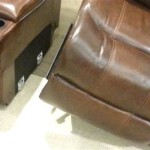The Peril and Prevention of Red Wine Stains on White Leather Sofas
White leather sofas represent a significant investment in both aesthetics and comfort. Their clean, bright appearance can elevate the ambiance of any living space. However, this pristine elegance comes with a heightened vulnerability to stains, particularly from substances like red wine. A single spill can quickly transform a luxurious centerpiece into a source of anxiety. Understanding the chemical properties of red wine, the porous nature of leather, and effective cleaning techniques is crucial for mitigating and preventing such disasters.
Red wine's staining power derives from its complex composition. It contains chromogens, which are colored molecules that readily bind to fibers. Anthocyanins, a specific type of chromogen, are particularly potent in red wines and contribute significantly to the deep red hue as well as the resulting stain. Tannins, another group of compounds present in red wine, act as a mordant, effectively fixing the color to the fabric. These tannins contribute to the wine’s astringency and also aid in the dye-like effect on surfaces, including leather. The alcohol content in wine further facilitates the penetration of these staining agents into the leather's porous structure.
Leather, whether genuine or synthetic, possesses a degree of porosity that varies depending on the type and treatment applied. Full-grain leather, known for its durability and natural appearance, tends to be more porous than top-grain or corrected-grain leather, which have undergone surface treatments to reduce imperfections and improve stain resistance. White leather, lacking any inherent pigmentation to mask stains, will display even the slightest discoloration with remarkable clarity. The porous nature of leather allows the red wine to seep into the material's fibers, making it difficult to remove completely. The longer the wine remains on the leather, the deeper it penetrates and the more challenging the stain becomes to treat.
Therefore, immediate action is paramount in minimizing the damage caused by a red wine spill. The first step is to blot the spill with a clean, absorbent cloth or paper towel. Avoid rubbing, which can spread the stain and drive it deeper into the leather. Apply gentle pressure to absorb as much of the liquid as possible. Continue blotting with fresh sections of the cloth or new paper towels until no more wine is being absorbed.
Key Point 1: Immediate Blotting and Initial Stain Mitigation
The initial response to a red wine spill on white leather is perhaps the most critical factor in determining the outcome of the stain removal process. As previously emphasized, blotting, rather than rubbing, is essential. The goal is to lift the wine from the surface and prevent it from setting into the leather's fibers. Consider using a slightly damp cloth to gently dilute the stain as you blot. This can help to loosen the wine and make it easier to absorb. However, be careful not to oversaturate the leather, as excessive moisture can also cause damage.
Following the initial blotting, several home remedies can be employed to further mitigate the stain. One common approach involves using salt or baking soda. These substances act as absorbents, drawing the wine out of the leather. Generously apply a layer of salt or baking soda to the affected area, ensuring that it completely covers the stain. Allow it to sit for several hours, or preferably overnight, to absorb the remaining wine. The salt or baking soda will gradually change color as it absorbs the liquid. Once it has dried, vacuum or brush it away gently.
Another popular home remedy involves using club soda. The carbonation in club soda is believed to help lift the stain from the leather. Pour a small amount of club soda onto a clean cloth and gently blot the stain. Avoid pouring the club soda directly onto the leather, as this can lead to oversaturation. Continue blotting until the stain begins to fade. Once the stain has been treated with club soda, blot the area with a clean, dry cloth to remove any excess moisture.
While these home remedies can be effective, they are not foolproof. The success of these methods depends on the severity of the stain, the type of leather, and the promptness of the treatment. In some cases, professional cleaning may be necessary to completely remove the stain without damaging the leather. It's always prudent to test any cleaning solution on an inconspicuous area of the sofa before applying it to the entire stain.
Key Point 2: Exploring Stain Removal Solutions
Beyond immediate blotting and absorbent remedies, several commercially available leather cleaners are specifically formulated to address stains without harming the material. When selecting a leather cleaner, choose one that is designed for use on light-colored or white leather. Avoid cleaners that contain harsh chemicals or solvents, as these can damage the leather's surface and cause discoloration. Always read the product label carefully and follow the manufacturer's instructions.
Before applying any leather cleaner to the stain, perform a spot test in an inconspicuous area, such as the back or underside of the sofa. This will help to ensure that the cleaner does not damage or discolor the leather. Apply a small amount of the cleaner to a clean cloth and gently rub it onto the test area. Allow it to sit for a few minutes and then wipe it away with a clean, damp cloth. Check for any adverse reactions, such as discoloration, fading, or cracking of the leather. If no adverse reactions occur, proceed with cleaning the stain.
To clean the stain, apply a small amount of the leather cleaner to a clean cloth and gently blot the affected area. Avoid rubbing vigorously, as this can spread the stain and damage the leather. Work in small sections, blotting the stain until it begins to fade. Once the stain has been treated, wipe the area with a clean, damp cloth to remove any residue from the cleaner. Finally, dry the area with a clean, dry cloth.
For more stubborn stains, consider using a leather stain remover that is specifically designed for red wine. These products typically contain enzymes or other stain-fighting agents that can help to break down the wine molecules and lift them from the leather. Follow the manufacturer's instructions carefully when using a leather stain remover. As with leather cleaners, always perform a spot test before applying the stain remover to the entire stain.
In some cases, professional leather cleaning may be the only option for completely removing a red wine stain, especially if the stain is old or particularly stubborn. Professional leather cleaners have access to specialized cleaning solutions and equipment that are not available to the general public. They also have the expertise and experience to safely and effectively remove stains without damaging the leather.
Key Point 3: Professional Cleaning and Preventative Measures
When considering professional cleaning, it is important to choose a reputable and experienced leather cleaning service. Ask for references and read online reviews to ensure that the cleaner has a good track record. Be sure to discuss the stain with the cleaner in detail, including the type of wine, the age of the stain, and any attempts that have been made to remove it. This will help the cleaner to determine the best course of action.
Even with the best cleaning techniques, preventing red wine stains in the first place is the most effective strategy. Consider using stain-resistant leather protectors on the sofa. These products create a barrier that repels liquids and prevents them from penetrating the leather. Apply the protector according to the manufacturer's instructions and reapply it periodically to maintain its effectiveness.
Another preventative measure is to avoid consuming red wine near the white leather sofa altogether. If this is not possible, take precautions to minimize the risk of spills. Use coasters under wine glasses and avoid placing them on unstable surfaces. Be careful when pouring or serving wine, especially when seated on the sofa. Consider using a wine preserver to prevent accidental spills from knocked-over bottles.
Furthermore, regular maintenance can help to keep the white leather sofa looking its best and prevent stains from setting in. Dust the sofa regularly with a soft cloth to remove dirt and debris. Condition the leather periodically to keep it supple and prevent it from drying out and cracking. Clean up spills promptly, even if they are not red wine. The sooner a spill is addressed, the easier it will be to remove.
Ultimately, owning a white leather sofa requires a commitment to vigilance and proactive care. While the risk of red wine stains is undeniable, understanding the principles of stain removal and implementing preventative measures can significantly mitigate the potential for disaster. Whether relying on home remedies, commercial cleaners, or professional services, a swift and informed response is the key to preserving the beauty and longevity of this luxurious furniture piece.

How To Remove Red Wine Stains From Leather Fabric And Wood

How To Easy Ways Remove Red Wine Stains From Sofas Plumbs

3 Ways To Remove Red Wine Stains From Upholstery Omega Carpet Cleaning

Spring Clean Do S And Don Ts Of Looking After Your Leather Sofa

How We Remove A Red Wine Stain On Fabric Sofa Guardsman In Home Care Repair

Chesterfield Handmade 3 Seater Sofa Settee Pimlico Wine Red Fabric In Era Style Sofas

Modern Living Room Led Furniture Set Wine And White Xtraa

Massoud Davidson 69 Slab Seat Chesterfield Sofa Red Wine

Living Room Of A House With White Marble Coffee Table Centerpiece Bottle Spanish Red Wine Two Crystal Glasses And In The Background Brown Leather Sofa

Chester Two Seater Sofa In Red Wine Velvet By Europa Antiques For At Pamono








